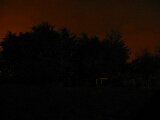
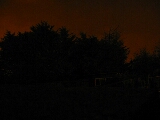
Ok so i have only had the camera since yesterday and have not used it for anything but pics of work chums and family and 2 pics of the trees in my back garden. When i ventured out to my garden last night it was cloudy, cold and miserable(much like Margret Thatcher). So there was no point in digging out my 4.5" reflector cos all i would have seen was rain and clouds. This little toy should be quite usefull for my astronomical purposes compared to the last camera i had, a Kodak DC215. The Kodak has no way to change shutter speed, the only adjustment it had was +/-2EV on the exposure, not too good. This meant that i could only take pictures of the moon and that was none to easy. Some may ask why use a digicam instead of an slr, the answer is i do use an slr to but it is not easy focussing or getting good shots without spending a small fortune on gadgets to help, added to that the fact that a 24 exposure film costs at least £3 and development costs at least another £4 the digicam makes a much cheaper alternative, all be it not quite such good quality.
Well as you can see there really is only one reason for buying this camera. The shutter speed! and, of course the girlfriend thing. The camera is the only one i could find locally at a reaonable price. The prices i was quoted varied hugely, a local family run camera specialist wanted £449 Jessops wanted £319.90. just goes to show that a little phone work can save a small fortune, remember that when you buy anything especially telescopes and cameras. The video capabilities of the camera give me the ability to shoot a 6 second avi then stack the frames together to give a far better image than any one single frame using AstroStack image stacking software. The high shutter speed is a requirement for any astrophotography weather you want to do tripod or telescope pictures. Although 15 seconds is nothing compared to what you can do with an SLR on the B or T setting it is still a big step up from the exposure compensation of the Kodak which only gives you a brighter or darker image.
Well thats all i can write for now, when i get a nice bit of weather i will try to get some planetary, cluster and nebulae images and add them to the page along with some more info about how the camera performs as an astrophotography tool.
I have had three good clear nights now since i bought the camera, the first night i just took the telescope out, i really couldnt be bothered to dig out the tripod and all the other gear that goes with it. That night remained clear untill i was yawning and tired. The second night (01/12/2002) i decided to get out the Minolta, tripod and cannon. The Minolta has a piggy back bracket on the scope for wide field(35mm) rough guided exposures. I placed the Canon on the tripod, set it to full manual mode, set the shutter speed to 15 seconds, and pointed it at M45. That night i had yet to eat so within an hour i was freezing and called it quits. I took about 10 exposures at minimum and maximum focal lengths (28 -> 105mm). At 15 seconds and full zoom trails are clearly evident, or maybe my cold hands where wobbling the camera after the shutter opened. See here for a couple of the better images.
Wednesday the 04 of december i already had the scope out by 6pm (oh the winter is nice) i had looked at M57, M31, M52 and a wobbly look at Saturn, i say wobbly because it was very low in the sky which means looking through hundreds of miles of atmosphere instead of just tens. That night i took about 50 pics most of which where through the scope via an adaptor comprising of an empty roll of insulating tape, an old film container with a 20mm Meade MA eyepiece jammed and taped into the end. Very agricultural but it worked (sort of). You can see a couple of the best images here. The scope fails to track acuratley enough for even a 1second exposure with eyepeice projection. I got a few pictures of saturn mostly over exposed at 1 second but i cant get the shutter speed down any less in manual mode. In fully automatic mode the camera foccues perfectly but fails to open the shutter for long enough and or to high an fstop.
For £320 you cant really expect too much from a digital camera, especially when being used in a feild that normally requires a great deal of specialised and expensive equipment. As a general use point and shoot camera the Canon IXUS 330 isnt really up to much. It dosent focus all that well unless you are standing a meter or so away from the subject. The cameras manual settings allow only either shutter speed adjustments or exsposure compensation (+/- 2EV) not both at the same time. There is no facility for changing apeture that i could find. But as demonstrated below a child of 3 can take a decent picture in auto mode with no more than a "Press that button" instruction. If you want a camera that can be used for both astrophotography and day to day imaging get a IXUS 330. Im sure with a bit more time and practive i will be getting good pictures of both terrestrial and astronomical subjects.
After much searching and toil on the internet i found Cam4you utilities. This is an excellent free program that gives huge control over both auto and manual modes of the camera, coupled to that the program also has a viewfinder function that puts the output of the LCD screen to your pc monitor. I have yet to test this gadget fully because i intend to use a video capture card such that i can see the viewfinder full screen. The last few months have not really given me much time to indulge in any more practice, suffice to say once i get the capture device i will start snaping again. This time i will try tripod supported afocal imagery, i will post images here shortly.
Images link through to full size versions. Hover over to see image weight.
| These images are taken with the camera placed on my shed roof with a 15 second exposure. As you can see the sky is very cloudy and there is no moon to dish out any light. | |
 |
 |
| My daughter(left) took the picture of my girlfriend(right) with no more instruction than "Press the button". So as you can see its a very easy camera to use, even a child of 3 can take good pics. | |
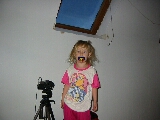 |
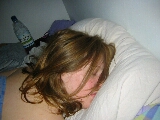 |
| Hover over the image for more info. Thumb nails contrast adjusted so you can see them ! | |
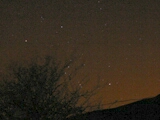 |
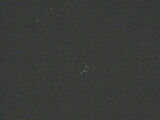 |
| These are taken through my Meade DS2114 4.5" reflector. Hover over the image for more info. Thumb nails contrast adjusted so you can see them ! | |
 |
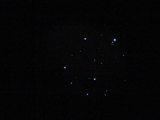 |